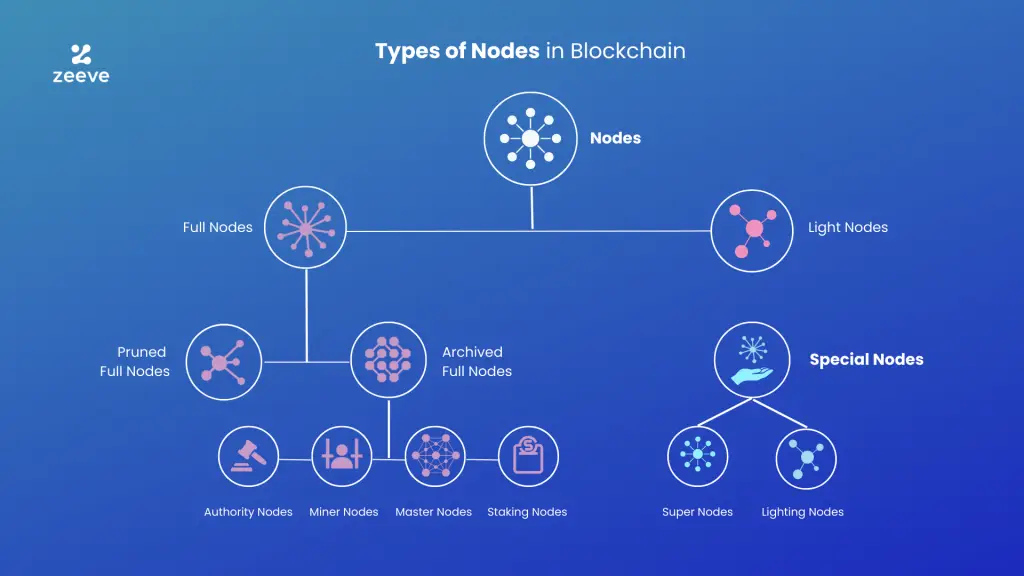Back
Node
Telos
Basics
By HackQuest
Sep 12,20245 min readWelcome to the Web3 world, where digital finance and applications are shown in a revolutionary way through the fusion of blockchain technology, cryptocurrencies, and a pioneering spirit. Are you overwhelmed by the wealth of terms in the Web3 world that you don’t understand? Are those slangs barriers for you to learn about Web3? Don’t worry! We’re here to explain the obscure terms to guide your learning. Today, we're diving into an essential concept in the world of Web3: [Node].
Overview
A blockchain node is any device or computer connected to a blockchain network. These nodes perform vital functions by maintaining a copy of the blockchain ledger, validating transactions, and propagating data across the decentralized network. Unlike centralized systems, where a single server handles operations, blockchain nodes create a distributed infrastructure that secures and decentralizes the entire network. Each node acts independently to verify and relay information, providing transparency and resilience.
There are various types of blockchain nodes, each playing a unique role within the network. Full nodes store a complete copy of the blockchain, light nodes maintain minimal data, and validator nodes play a central role in the consensus process by proposing and validating blocks. These nodes ensure that the blockchain remains trustless and secure.

Source: LinkedIn
How Blockchain Nodes Work
Blockchain nodes operate within a peer-to-peer (P2P) network, ensuring that the system functions without a central authority. Here’s a breakdown of how they function:
1.Storing Data: Each node stores a copy of the blockchain ledger. Full nodes hold a complete record of every transaction that has occurred on the network, while light nodes store a limited portion of the data.
2.Transaction Validation: Nodes validate transactions by ensuring that they comply with the network's protocol. This includes verifying signatures, ensuring that the sender has sufficient funds, and confirming that transactions follow the blockchain’s rules.
3.Relaying Information: Once a transaction is validated, nodes propagate this information to other nodes, keeping the network synchronized. This is critical to maintaining the consensus across the distributed network.
4.Consensus Participation: Validator nodes play a direct role in consensus mechanisms like Proof of Work (PoW) or Proof of Stake (PoS), where they propose new blocks and validate the inclusion of transactions in the blockchain. This ensures the integrity and security of the blockchain.
Types of Blockchain Nodes
There are several types of blockchain nodes, each with specific responsibilities:
●Full Nodes: These nodes store the entire blockchain history and validate transactions, ensuring the integrity of the network. They play a crucial role in decentralized security.
●Light Nodes: Light nodes store only essential information, such as block headers. They rely on full nodes for detailed verification but are lightweight and easier to operate.
●Validator Nodes: Essential in proof-of-stake (PoS) networks, validator nodes propose and validate blocks. They secure the network by staking cryptocurrency, incentivizing honest behavior.
●Master Nodes: Unlike full or validator nodes, master nodes perform specialized tasks, such as governance functions or enhancing transaction privacy, without creating new blocks.
●Mining Nodes: In proof-of-work (PoW) systems, mining nodes validate transactions by solving cryptographic puzzles, adding new blocks to the blockchain and receiving rewards in return.
●Archival Nodes: Archival nodes store the entire blockchain, including all past states and data. They are vital for querying historical data and maintaining blockchain transparency.
●Authority Nodes: Found in permissioned blockchains, authority nodes are controlled by trusted entities that manage and validate transactions, often used in enterprise settings.
●SPV Nodes (Simplified Payment Verification): These nodes verify transactions by downloading only block headers. They enable faster verification without needing the full blockchain.
●Super Nodes: Acting as intermediaries, super nodes connect other nodes and ensure the availability of data across the network, enhancing reliability and redundancy.
●Staking Nodes: In PoS systems, staking nodes lock up funds (stake) to help validate transactions, participate in governance, and receive rewards based on their stake. They ensure network security by aligning incentives.

Source: Zeeve
Importance of Blockchain Nodes
Blockchain nodes are vital to the security, transparency, and decentralization of blockchain networks. Their distribution across various geographic locations and network participants ensures that no single entity controls the blockchain. This decentralization makes the network resistant to censorship and tampering.
Nodes are also critical for achieving consensus, as they independently verify transactions and blocks. With many nodes involved in the validation process, blockchains can remain transparent, with each transaction traceable to its origin. Additionally, nodes allow blockchain networks to be self-regulating, where a community of validators maintains the integrity of the network rather than relying on a central authority.
The role of nodes also extends to the scalability of blockchain networks. Full nodes provide a comprehensive record of the blockchain but require significant computational resources. Light nodes offer a more efficient alternative by reducing the data they store, enabling more participants to join the network without overburdening their hardware. Validator nodes ensure network efficiency by securing the blockchain through consensus.
Challenges of Running Blockchain Nodes
Running a blockchain node, particularly a full or validator node, requires significant resources. Full nodes must store and manage the entire blockchain ledger, which grows as more transactions and blocks are added. This can result in high storage, bandwidth, and computational costs. Validator nodes also require participants to lock a substantial amount of cryptocurrency in Proof of Stake (PoS) systems, which can act as a barrier to entry for many users.
Additionally, maintaining a node requires reliable uptime and security measures. As nodes are responsible for validating transactions and blocks, any downtime or security breach can impact the overall health of the blockchain network. For individuals or organizations looking to participate, there may be technical challenges in setting up and managing nodes.
Future of Blockchain Nodes
As blockchain technology evolves, efforts are underway to make node operations more efficient and accessible. Layer 2 solutions, sharding, and advanced consensus mechanisms are being developed to reduce the computational burden on nodes while ensuring the security and scalability of the network.
Another growing trend is the implementation of light clients, which allow users to interact with the blockchain without running a full node. This reduces hardware and storage requirements while still providing a high level of security for network participants. By streamlining node operations and developing scalable solutions, the blockchain industry is working toward making nodes more accessible to a broader range of users and developers.
Moreover, blockchain technology continues to see new use cases beyond cryptocurrency, expanding into sectors like supply chain management, healthcare, and voting systems. As this trend continues, nodes will be critical to maintaining decentralized systems and ensuring transparency, integrity, and security in various industries.
Conclusion
Blockchain nodes are the cornerstone of decentralized networks, enabling trustless, transparent, and secure blockchain operations. As the blockchain ecosystem continues to evolve and expand into new applications, nodes will play an increasingly important role in ensuring the scalability and security of these systems. While running a node can be resource-intensive, advances in blockchain technology aim to reduce these burdens, making node participation more accessible for users. The future of blockchain nodes looks promising as they continue to support the decentralized infrastructure of Web3.